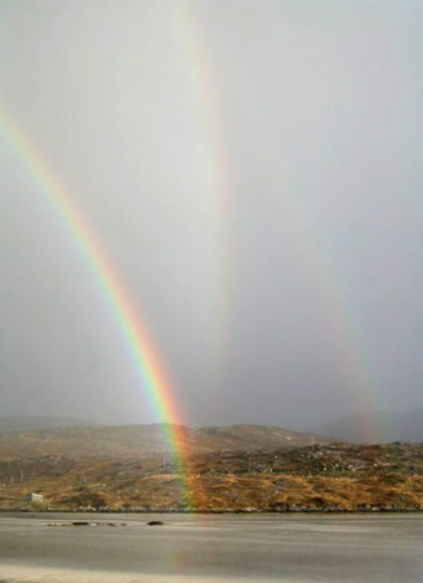Reflection Rainbows
Reflection Rainbows: A Phenomenon of Nature's Beauty
When it comes to atmospheric optics, rainbows are a fascinating subject. While most of us are familiar with the primary and secondary rainbows that form from the refraction and reflection of sunlight in raindrops, there is another type of rainbow that captivates the eyes and imagination: the reflection rainbow.
What are Reflection Rainbows?
Reflection rainbows, also known as reflected rainbows, are a mesmerizing spectacle that occurs when sunlight is reflected from calm water or wet surfaces, such as sand. Unlike the primary and secondary rainbows that form in the sky, reflection rainbows appear closer to the ground, often curving between the primary and secondary rainbows.
The Magic of Multiple Bows
In certain instances, you may be lucky enough to witness not just one, but multiple reflection rainbows. Imagine being surrounded by a scene where four rainbows dance in harmony, creating a breathtaking display of colors. Such a spectacle can occur in places like Luskentyre Bay on South Harris, Scottish Hebrides, where the prevailing warm southwesterly winds from the Atlantic Ocean bring frequent showers of fine rain interspersed with skies of exceptional purity.
Understanding the Anatomy of Reflection Rainbows
To fully appreciate reflection rainbows, it's essential to understand their unique characteristics. The centers of reflection bows align with the sun's altitude, known as the anthelic point. This point is at the same distance above the horizon as the centers of normal bows are below it at the antisolar point. In other words, while normal bows appear below the horizon, reflection bows intersect at the horizon.
The Influence of Sun Position
The intensity and visibility of reflection rainbows are influenced by the position of the sun. When the sun is low on the horizon, its light is reflected most strongly from water surfaces, resulting in brighter and more vibrant reflection rainbows. As the sun gets lower, both normal and reflection bows draw closer together, creating a captivating interplay of colors and light.
The Source of Reflected Light
The source of the reflected light that forms reflection rainbows is typically water behind the observer, towards the direction of the sun. This means that when you witness a reflection rainbow, the water surface reflecting the sunlight is usually located behind you. However, in some cases, the reflected light source can be in front of you, resulting in only the base of the reflected bow being visible.
The Enchanting Beauty of the Scottish Western Isles
While reflection rainbows can occur in various locations around the world, the Scottish Western Isles are particularly renowned for their abundance of reflection bows. The prevailing warm southwesterlies from the Atlantic Ocean bring frequent showers of fine rain to this region, creating an ideal environment for the formation of reflection rainbows. The many bays and inlets found in the Scottish Western Isles offer ample opportunities for sunlight to be reflected, resulting in stunning displays of nature's beauty.
In conclusion, reflection rainbows are a captivating atmospheric phenomenon that adds a touch of enchantment to our surroundings. Witnessing multiple rainbows dancing across the sky and reflecting off calm waters is a truly awe-inspiring experience. Whether you find yourself exploring the Scottish Western Isles or any other location blessed with calm waters and clear skies, keep an eye out for these mesmerizing reflection rainbows. They are nature's way of reminding us of the magical wonders that surround us.

Multiple Bows at Luskentyre Bay on South Harris, Scottish Hebrides. Imaged by Ann Bowker (Mad about Mountains) on 10th May 2003. ©2003 Ann Bowker
There are at least four rainbows in the scene at left. The strangely oriented bow curving between the primary and secondary is a primary 'reflect__ion__ rainbow' produced by sunlight beaming upwards after reflection from calm water or wet sand. In this instance the sun's rays were reflected from another bay behind the camera.
And the fourth bow? Look in the wet sand. There is a fragment of bow. This is a 'reflect__ed__ rainbow'.
The Scottish Western Isles are favoured places for reflection bows. The prevailing warm south westerlies from the Atlantic Ocean bring frequent showers of fine rain interspersed by skies of exceptional purity whose sunlight is reflected in the many bays and inlets.

The centres of reflection bows are at the same altitude as the sun - the anthelic point. This is the same distance above the horizon as the centres of normal bows are below it at the antisolar point.
The normal bow and its corresponding reflection bow intersect at the horizon.
Reflection bows are usually brightest when the sun is low because then its light is reflected most strongly from water surfaces. The normal and reflection bows draw closer together as the sun gets lower.
The source of the reflected light is usually water behind you, i.e. sunwards. It can be in front of you but then only the base of the reflected bow will be seen.
Note: this article has been automatically converted from the old site and may not appear as intended. You can find the original article here.
Reference Atmospheric Optics
If you use any of the definitions, information, or data presented on Atmospheric Optics, please copy the link or reference below to properly credit us as the reference source. Thank you!
-
<a href="https://atoptics.co.uk/blog/reflection-rainbows/">Reflection Rainbows</a>
-
"Reflection Rainbows". Atmospheric Optics. Accessed on November 17, 2024. https://atoptics.co.uk/blog/reflection-rainbows/.
-
"Reflection Rainbows". Atmospheric Optics, https://atoptics.co.uk/blog/reflection-rainbows/. Accessed 17 November, 2024
-
Reflection Rainbows. Atmospheric Optics. Retrieved from https://atoptics.co.uk/blog/reflection-rainbows/.